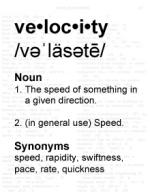|
This section contains 374 words (approx. 2 pages at 300 words per page) |
Velocity is the rate of change of an object’s distance with time.
The velocity of an object includes specification of its direction. For example, the velocity of a car may be 60 miles per hour (mph) (96.6 kph) west, or 5.45 yd (5 m/sec) downward. (Such quantities, which have both a magnitude and a direction, are called vectors.) The value of the velocity, without specifying the direction, is called the speed. Speed is what is displayed on a car’s speedometer.
An object’s velocity is always relative to an observer. That is, an observer along the side of a road might see a car go by with a certain velocity, say, 60 mph to the east. But a different observer in a car also going 60 mph to the east would see the first car as being at rest relative to him--it would have no velocity. The two observers, ground and car, each think themselves to be at rest, and only see velocity relative to them. But the velocity values are very different.
Albert Einstein built on this concept of relative velocities to construct his special theory of relativity. This theory, which has been verified and is an accepted principle in physics, holds that no object can travel faster than a limiting speed, which is the speed of light. Einstein showed that unexpected things occur as objects travel with speeds near that of light--their mass increases, they shrink in size, etc.
Angular velocity is the velocity of an object traveling in a circle. It is measured by the amount of angle an object sweeps out in a certain period of time. An object that takes 1 second to travel around a circle, such as a rock swung around on the end of a rope, has an angular velocity of 1 revolution per second, or 360 degrees per second. The direction of the object changes as it moves around--at any instant its direction is tangential to the circle.
Velocity is related to other basic concepts of physics. The mass of an object multiplied by its velocity is the object's momentum, also a vector. The rate of change of the velocity with time is the acceleration, also a vector quantity. An object with a constant velocity thus has no acceleration.
|
This section contains 374 words (approx. 2 pages at 300 words per page) |


